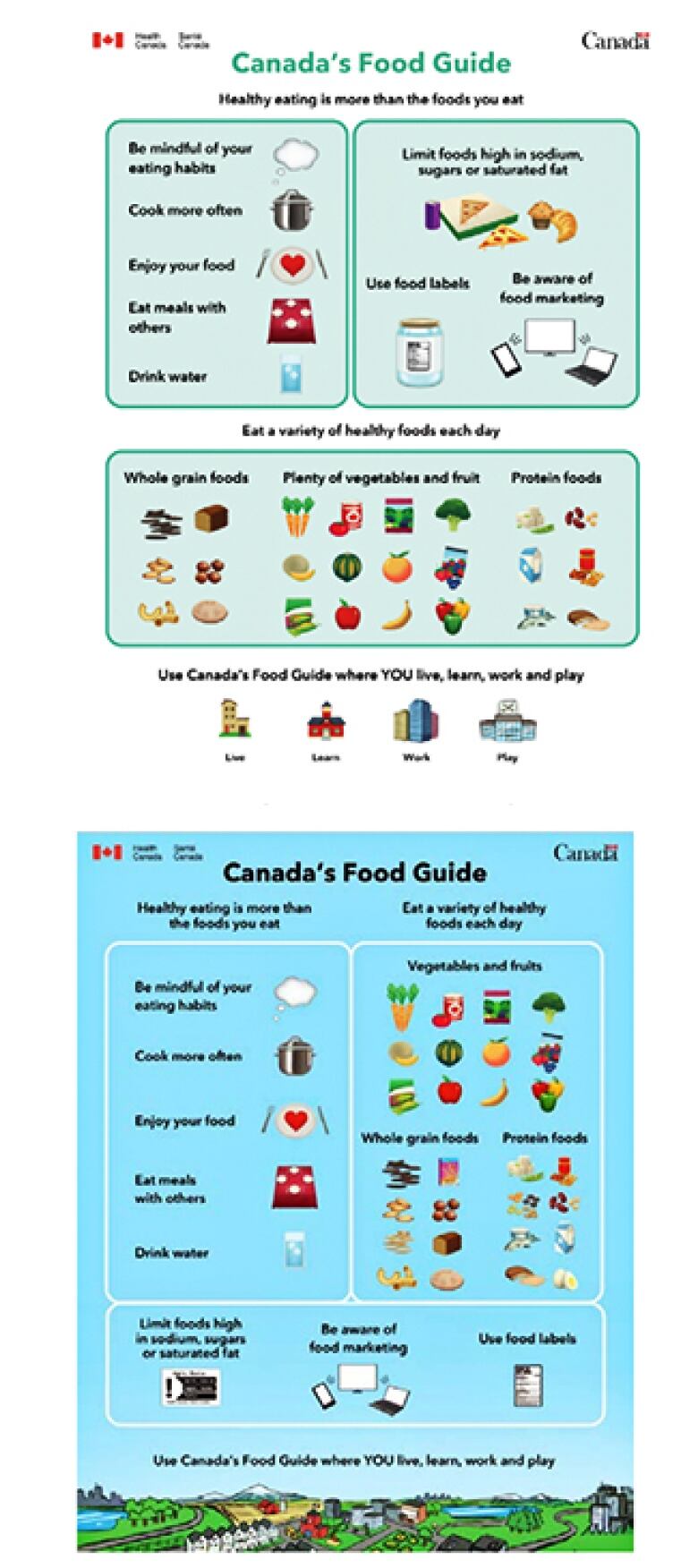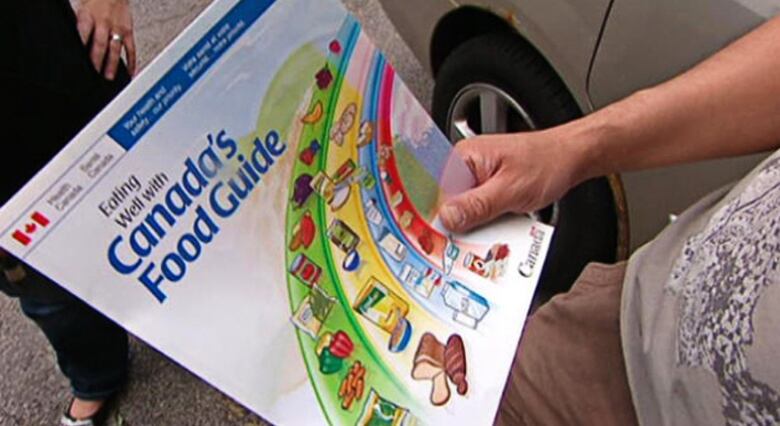The long road to a new Canada's Food Guide
How many people does it take to write a guide for healthy eating? More than 26,000 and counting

A rainbow of lively food illustrations hanging on the classroom wall that's how most Canadians rememberCanada's Food Guide.
But behind that brightly coloured document is a long history of political wrangling and industry lobbying a tradition that continues today as Health Canada prepares to introduce a revised food guide sometime in the next few weeks.
- See the creative ways other countries around the world tackle food guidance
- The Nature of Things: Food for Thought
The process has so far takenthree years, withHealth Canada hiring variousmarket research companies to consult with more than26,000 Canadians.Health Canada has also held briefing sessions with various health associations and industry groups.
It seems no detail in the new food guide is too small to be focus-grouped, includingwhether Canadiansprefer a blue or green document and whether they would like to see illustrations or actual photographs of food.
It should be a science/health document. And it has been politicized beyond belief.- Nick Saul, Community Food Centres Canada
Meanwhile, Canada's dairy industry is warning that proposed changes to the food guide could harm the dairy sector. And there have been reports of interagency pressure,with officials from the Ministry ofAgriculture lobbying Health Canada on behalf of industry.
How did a guide to healthy eating become so complicated? Becausesince the beginning, Canada's Food Guide has been a political document.

In 1942,"Canada's Official Food Rules" were firstdevelopedto fatten up Canadian soldiers so they could better fight in the Second World War.
"In World War II, that made a lot of sense," said University of Guelph food historian Ian Mosby, who has studied the history of Canada's Food Guide."It was about producing the next generation of soldiers, the next generation of industrial workers. And the problem at the time was this perceived problem of malnutrition."
The food guide has been revised seven times since then, withthe current version last being updated in2007.
"It became harder and harder to take things out of the food guide, or to recommend to Canadians to eat less of things that were already in the food guide," said Mosby. "It still reflects some of those ideasthose fossilized ideas of how we should eat."
Food industry lobby
And over the years, the food industry continued to lobby for more prominence.
"The first industry influence was the milk industry calling for higher servings of milk to meet maximum nutritional requirements," said Mosby.

In 1992, Health Canada increased the recommended servings of meat and dairy foods in response to industry pressure.
All of that industry lobbying has hurt the food guide's credibility, according to a Health Canadaresearch documentprepared as part of the food guide revision.
So this time around, Health Canada declared that"during the policy development of the new Canada's Food Guide, officials from Health Canada's Office of Nutrition Policy and Promotion will not be meeting with representatives from the food and beverage industry."
But there are reports of industry officials lobbying other federal government departments over therevisions. And a few of industry's fears were outlinedin a report by the federal agriculturalcommittee, entitledA Food Policy for Canada.
"They worry that the revised version of the guide will favour one food group over another, including vegetable-based sources of protein over animal-based ones.The Canadian National Millers Association is concerned that the new food guide may encourage consumers to give up enriched white bread, hamburger and hot dog buns, and other bakery products made with enriched flour."
In response to those concerns, the committee officially recommended that during the food guide revision, "...the government work with the agriculture andagri-foodsector to ensure alignment and competitiveness for domestic industries."
But should Canada's official guidance on a healthy diet even be concerned about the effect on industry?
"It should be a science/health documentand it has been politicized beyond belief," said anti-poverty activistNick Saul, co-founder of Community Food CentresCanada.

Saul, whoparticipated in the online consultations, isconcerned about how industry might have influenced the food guide revision process.
"Unhealthy food is the leading risk factor for death and disability. So what we put in our body is extremely important.We have a food system that is very focused on sales and profits, and the food that is often produced through this system is not good for our health."
"If the food guide does a good job, certain industries will be upset," said Mosby.
End of the 4 'food groups'
Early prototypes sent to focus groups showedthat the familiar four "food groups" are gone. Meat anddairy no longer have theirown category:They're grouped under "protein foods."
Other flash points include fruit juice: Will it remain listed under "vegetables and fruit?" Or will it disappear altogether from the food guide?
Health Canada has tried to quell controversy by promising the new food guide will still recommend a variety of food.
"As indicated in theproposed guiding principles, the new food guide will continue to recommend Canadians choose a variety of nutritious foods and beverages, whichincludes lowerfat milk and yogurt, and cheeses lower in sodium and fat," spokespersonGeoffroyLegault-Thiviergesaid in an email to CBC News.

Canadians ignoring food guide's advice
The current food guide was introduced 12 years ago and the familiar rainbow creates strong "brand recognition," according to Health Canada's market research.
But although Canadians mightrecognize Canada's Food Guide, they're not following its advice aboutwhat to eat.
"Less than half the food choices in the dairy group were 'in line' with food guide guidance," Health Canada's evidence review revealed. "And more than 60 per cent of the choices in the meat and alternatives group failed to match food guide recommendations."

The majority of Canadians had "low intakes of vegetables and fruit; milk and alternatives; and whole grains,"the report said. "About one-third of total calories came from foods higher in fat, sugar or salt."
Most people didn't manage to eat even one serving of dark green or orange vegetable every dayeven though the food guide recommends it.
Health Canada also found that most Canadians get their nutritional information advice from other sources;Canada's Food Guide ranks fourth, behind the internet, friends and television.
Can't address real barriers to healthy eating
Health Canada is also testing lifestyle advice in the draft copies of the food guide. There are suggestions to "be mindful of your eating habits," "enjoy your food," and "cook more often."
But societal barriers to healthy eating can't be overcome by a simple document, saidMosby.
"It's this idea that people are unhealthy because they don't know how to eat.But there are all these structural reasons why people can't afford healthy food, don't have time to cook healthy food.
"The people who the food guide is really aimed at are already struggling to just make ends meet,so the importance placed on the food guide is perhaps misplaced."
So when exactly will Canadians get to see the new food guide?
"While an exact date for the launch is to be determined,we expect to release the new food guide early in 2019," said Health Canada.












_(720p).jpg)


 OFFICIAL HD MUSIC VIDEO.jpg)
.jpg)



























































































